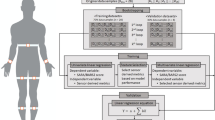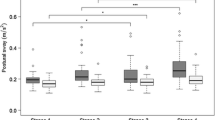Abstract
We reported previously that the average medial–lateral gait amplitude while walking on a straight path determined using triaxial accelerometers fixed on the middle of the upper back may be a quantitative and concise indicator for the severity of cerebellar ataxia. Considering that gait ataxia is a typical initial symptom in a variety of spinocerebellar degeneration (SCD), we aimed to develop quantitative biomarkers for cerebellar ataxia as metric variables. We used triaxial accelerometers to analyze gait parameters in 14 patients with SCD at 3 points over 3 years (at baseline, 1.5 years and 3 years). Analysis of covariance (ANCOVA) models adjusted for the baseline scores were used to estimate sample sizes. The mean medial–lateral amplitude (ML) gained by a triaxial accelerometer fixed on upper back could detect the each 1.5-year change. In the 14 patients, the mean ML(m) was 0.032 ± 0.007(SD) at entry, 0.037 ± 0.008 after 1.5-year follow, and 0.042 ± 0.020 after 3-year follow. In contrast, SARA gait scores were 2.9, 2.9, and 3.0, respectively. The responsiveness of the quantitative evaluation of gait ataxia by triaxial accelerometers is higher than that of the SARA within a 1.5-year follow-up period. Gait analysis by triaxial accelerometers will be complementary to the evaluation of scales like SARA in the assessment of clinical severity of SCD patients in early stage.



Similar content being viewed by others
References
Schmitz-Hubsch T, du Montcel ST, Baliko L, Berciano J, Boesch S, Depondt C, et al. Scale for the assessment and rating of ataxia: development of a new clinical scale. Neurology. 2006;66:1717–20. https://doi.org/10.1212/01.wnl.0000219042.60538.92.
Sato K, Yabe I, Soma H, Yasui K, Ito M, Shimohata T, et al. Reliability of the Japanese version of the Scale for the Assessment and Rating of Ataxia (SARA). Brain Nerve. 2009;61:591–5.
Berg KO, Wood-Dauphinee SL, Williams JI, Maki B. Measuring balance in the elderly: validation of an instrument. Can J Public Health. 1992;83(Suppl 2):S7–11.
Matsushima M, Yabe I, Uwatoko H, Shirai S, Hirotani M, Sasaki H. Reliability of the Japanese version of the Berg balance scale. Intern Med. 2014;53:1621–4.
Takakusaki K, Chiba R, Nozu T, Okumura T. Brainstem control of locomotion and muscle tone with special reference to the role of the mesopontine tegmentum and medullary reticulospinal systems. J Neural Transm (Vienna). 2016;123:695–729. https://doi.org/10.1007/s00702-015-1475-4.
Takakusaki K, Takahashi M, Obara K, Chiba R. Neural substrates involved in the control of posture. Adv Robot. 2016;31:2–23. https://doi.org/10.1080/01691864.2016.1252690.
Homma Y, Nonaka S, Matsuyama K, Mori S. Fastigiofugal projection to the brainstem nuclei in the cat: an anterograde PHA-L tracing study. Neurosci Res. 1995;23:89–102.
Mori S, Matsui T, Kuze B, Asanome M, Nakajima K, Matsuyama K. Stimulation of a restricted region in the midline cerebellar white matter evokes coordinated quadrupedal locomotion in the decerebrate cat. J Neurophysiol. 1999;82:290–300. https://doi.org/10.1152/jn.1999.82.1.290.
Bostan AC, Dum RP, Strick PL. Cerebellar networks with the cerebral cortex and basal ganglia. Trends Cogn Sci. 2013;17:241–54. https://doi.org/10.1016/j.tics.2013.03.003.
Shaikh AG, Meng H, Angelaki DE. Multiple reference frames for motion in the primate cerebellum. J Neurosci. 2004;24:4491–7. https://doi.org/10.1523/JNEUROSCI.0109-04.2004.
Timmann D, Horak FB. Perturbed step initiation in cerebellar subjects: 2. Modification of anticipatory postural adjustments. Exp Brain Res. 2001;141:110–20. https://doi.org/10.1007/s002210100858.
Yabe I, Matsushima M, Soma H, Basri R, Sasaki H. Usefulness of the Scale for Assessment and Rating of Ataxia (SARA). J Neurol Sci. 2008;266:164–6. https://doi.org/10.1016/j.jns.2007.09.021.
Shirai S, Yabe I, Matsushima M, Ito YM, Yoneyama M, Sasaki H. Quantitative evaluation of gait ataxia by accelerometers. J Neurol Sci. 2015;358:253–8. https://doi.org/10.1016/j.jns.2015.09.004.
Iosa M, Fusco A, Morone G, Paolucci S. Development and decline of upright gait stability. Front Aging Neurosci. 2014;6:14. https://doi.org/10.3389/fnagi.2014.00014.
Iosa M, Picerno P, Paolucci S, Morone G. Wearable inertial sensors for human movement analysis. Expert Rev Med Devices. 2016;13:641–59. https://doi.org/10.1080/17434440.2016.1198694.
ATS Committee on Proficiency Standards for Clinical Pulmonary Function Laboratories. ATS statement: guidelines for the six-minute walk test. Am J Respir Crit Care Med. 2002;166:111–7. https://doi.org/10.1164/ajrccm.166.1.at1102.
Katsuno M, Banno H, Suzuki K, Takeuchi Y, Kawashima M, Yabe I, et al. Efficacy and safety of leuprorelin in patients with spinal and bulbar muscular atrophy (JASMITT study): a multicentre, randomised, double-blind, placebo-controlled trial. Lancet Neurol. 2010;9:875–84. https://doi.org/10.1016/S1474-4422(10)70182-4.
May S, Gilman S, Sowell BB, Thomas RG, Stern MB, Colcher A, et al. Potential outcome measures and trial design issues for multiple system atrophy. Mov Disord. 2007;22:2371–7. https://doi.org/10.1002/mds.21734.
Terashi H, Utsumi H, Ishimura Y, Takazawa T, Okuma Y, Yoneyama M, et al. Deficits in scaling of gait force and cycle in parkinsonian gait identified by long-term monitoring of acceleration with the portable gait rhythmogram. ISRN Neurol. 2012;2012:306816. https://doi.org/10.5402/2012/306816.
Schmitz-Hubsch T, Fimmers R, Rakowicz M, Rola R, Zdzienicka E, Fancellu R, et al. Responsiveness of different rating instruments in spinocerebellar ataxia patients. Neurology. 2010;74:678–84. https://doi.org/10.1212/WNL.0b013e3181d1a6c9.
Fazio P, Granieri G, Casetta I, Cesnik E, Mazzacane S, Caliandro P, et al. Gait measures with a triaxial accelerometer among patients with neurological impairment. Neurol Sci. 2013;34:435–40. https://doi.org/10.1007/s10072-012-1017-x.
Matsushima A, Yoshida K, Genno H, Murata A, Matsuzawa S, Nakamura K, et al. Clinical assessment of standing and gait in ataxic patients using a triaxial accelerometer. Cerebellum Ataxias. 2015;2:9. https://doi.org/10.1186/s40673-015-0028-9.
Hickey A, Gunn E, Alcock L, Del Din S, Godfrey A, Rochester L, et al. Validity of a wearable accelerometer to quantify gait in spinocerebellar ataxia type 6. Physiol Meas. 2016;37:N105–N17. https://doi.org/10.1088/0967-3334/37/11/N105.
Stoodley CJ, Valera EM, Schmahmann JD. Functional topography of the cerebellum for motor and cognitive tasks: an fMRI study. Neuroimage. 2012;59:1560–70. https://doi.org/10.1016/j.neuroimage.2011.08.065.
Yabe I, Matsushima M, Yoshida K, Ishikawa K, Shirai S, Takahashi I, et al. Rare frequency of downbeat positioning nystagmus in spinocerebellar ataxia type 31. J Neurol Sci. 2015;350:90–2. https://doi.org/10.1016/j.jns.2014.12.042.
Acknowledgments
We thank all patients and control individuals for their active cooperation. We thank Mitsuru Yoneyama, MS, Mitsubishi Chemical Corporation Yokohama R&D Center, Yokohama, Japan, for data processing.
Funding
This work was supported by a Grant from the Japan Agency for Medical Research and Development (to H.S. and I.Y.), and by a Grant from the Research Committee on the Medical Basis of Motor Ataxias, Health and Labor Sciences Research Grants, The Ministry of Health, Labor and Welfare, Japan (to H.S.)
Author information
Authors and Affiliations
Corresponding author
Ethics declarations
This clinical study was approved by the ethics panels of Hokkaido University Hospital and Kushiro Rosai Hospital.
Additional information
Publisher’s Note
Springer Nature remains neutral with regard to jurisdictional claims in published maps and institutional affiliations.
Rights and permissions
About this article
Cite this article
Shirai, S., Yabe, I., Takahashi-Iwata, I. et al. The Responsiveness of Triaxial Accelerometer Measurement of Gait Ataxia Is Higher than That of the Scale for the Assessment and Rating of Ataxia in the Early Stages of Spinocerebellar Degeneration. Cerebellum 18, 721–730 (2019). https://doi.org/10.1007/s12311-019-01025-5
Published:
Issue Date:
DOI: https://doi.org/10.1007/s12311-019-01025-5




